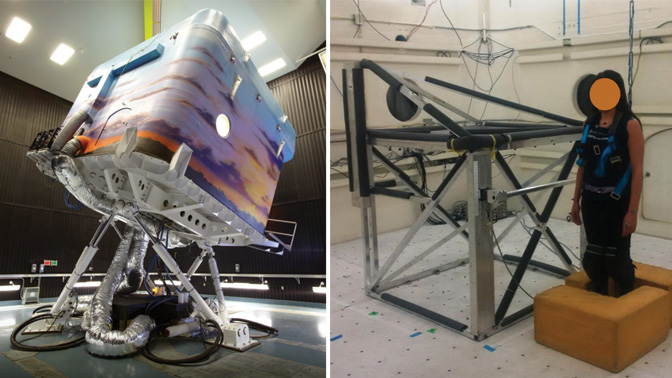
Canadians pride themselves on their ability to thrive despite wintery weather. However, icy and snowy conditions increase the risk of an already common problem: falls. These can happen at any moment—for example, when tripping on an irregular surface, when slipping on ice, when navigating stairs or while bending down to pick something up.
One of the main ways that we recover balance during a fall is by grasping on to something. Therefore, handrails are important installations for preventing falls; but, little is known about how the height of the handrail affects the speed and accuracy with which people can grasp it, or the ability to re-stabilize once handrail grasping has occurred.
To address this gap in knowledge, TRI Scientist Dr. Alison Novak and her graduate students Vicki Komisar and Konika Nirmalanathan initiated a study in young healthy adults. The research team asked study participants to stand on a robotic platform next to a handrail while wearing a safety harness. Three different handrail heights were tested. The platform was programmed to deliver quick and calculated movements that made participants fall either forward or backward. The resulting falls were recorded with motion capture cameras, while handrail sensors recorded forces applied to the rail.
The team found that falling backward resulted in less control over balance recovery than when falling forward—leading participants to grasp the handrail more aggressively. Moreover, the ability to recover balance and control during the fall increased as the height of the handrail increased; and, as handrail height increased, the forces that participants applied to the handrail during balance recovery decreased. This suggests that higher handrails (within the ranges tested) might provide greater stability with reduced physical demands.
“The handrail heights that we tested are similar to those in the International Building Code and the Ontario Building Code, so the results of our study are highly applicable and could inform the development of new standards,” explains Dr. Novak. “Future research should include older adults and people with mobility or balance impairments in order to investigate how handrail design can be improved to prevent falls in these individuals.”
This work was supported by the Canadian Institutes of Health Research, AGE-WELL, Toronto Rehabilitation Institute, the University of Toronto and the Toronto Rehab Foundation.
Komisar V, Nirmalanathan K, Novak AC. Influence of handrail height and fall direction on center of mass control and the physical demands of reach-to-grasp balance recovery reactions. Gait Posture. 2017 Dec 14. doi: 10.1016/j.gaitpost.2017.12.009.




